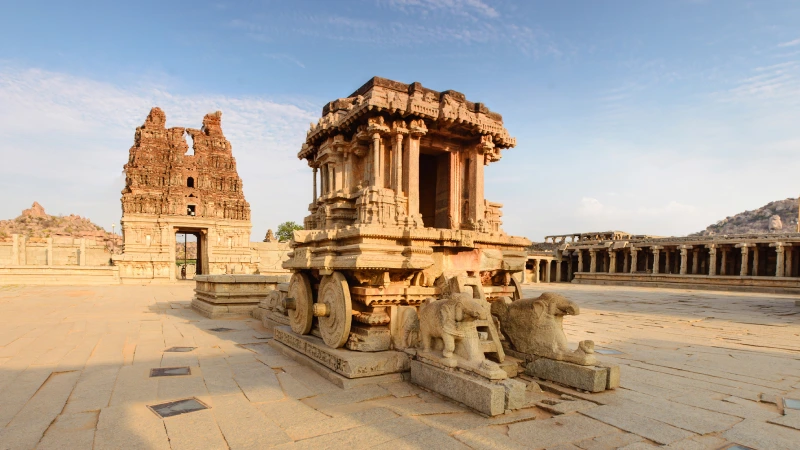Hampi, a UNESCO World Heritage Site in Karnataka, India, is a treasure trove of ancient temples that showcase the grandeur of the Vijayanagara Empire. These temples are not just places of worship but also architectural marvels that reflect the rich cultural and spiritual heritage of the region. In this guide, we’ll take you through the top temples in Hampi, their history, architectural significance, and tips for visiting them.
Why Hampi’s Temples Are a Must-Visit
Hampi’s temples are more than just religious sites; they are a testament to the region’s glorious past. Here’s why you should explore them:
- Architectural Brilliance: The temples feature intricate carvings, massive pillars, and stunning sculptures.
- Spiritual Significance: Many temples are still active places of worship, offering a serene and spiritual atmosphere.
- Historical Importance: These temples are closely tied to the history of the Vijayanagara Empire.
- Cultural Experience: Visiting these temples allows you to immerse yourself in the local culture and traditions.
Top Temples to Visit in Hampi
1. Virupaksha Temple: The Heart of Hampi
The Virupaksha Temple is one of the oldest and most famous temples in Hampi, dedicated to Lord Shiva. It has been a place of worship since the 7th century.
- History: The temple was expanded during the Vijayanagara Empire and is still an active place of worship.
- Architectural Highlights:
- Gopuram (Tower): The towering gopuram is a landmark of Hampi.
- Pillars: The temple features intricately carved pillars depicting scenes from Hindu mythology.
- Courtyards: The temple complex includes several courtyards and smaller shrines.
- Pro Tip: Visit during the annual Virupaksha Temple Festival for a vibrant cultural experience.
2. Vittala Temple: The Iconic Stone Chariot
The Vittala Temple is one of the most iconic landmarks in Hampi, known for its stunning architecture and the famous stone chariot.
- History: Built in the 15th century, the temple is dedicated to Lord Vittala, an incarnation of Lord Vishnu.
- Architectural Highlights:
- Stone Chariot: The chariot is a symbol of Hampi and features intricate carvings.
- Musical Pillars: The temple’s pillars produce musical notes when tapped.
- Mandapas (Halls): The temple complex includes several mandapas with beautiful carvings.
- Pro Tip: Visit early in the morning to avoid the crowds and enjoy the serene atmosphere.
3. Hazara Rama Temple: The Temple of a Thousand Ramas
The Hazara Rama Temple is a unique temple known for its bas-reliefs depicting scenes from the Ramayana.
- History: Built in the early 15th century, the temple was used by the royal family for private worship.
- Architectural Highlights:
- Bas-Reliefs: The temple walls are adorned with intricate carvings depicting the Ramayana.
- Courtyard: The temple features a large courtyard with beautifully carved pillars.
- Sanctum: The sanctum houses an idol of Lord Rama.
- Pro Tip: Take your time to explore the carvings and learn about the stories they depict.
4. Achyutaraya Temple: The Hidden Gem
The Achyutaraya Temple is a lesser-known but equally stunning temple located near the Hampi Bazaar.
- History: Built in the 16th century, the temple is dedicated to Lord Tiruvengalanatha, a form of Lord Vishnu.
- Architectural Highlights:
- Pillars: The temple features massive pillars with intricate carvings.
- Courtyard: The large courtyard is surrounded by beautifully carved walls.
- Sanctum: The sanctum houses an idol of Lord Tiruvengalanatha.
- Pro Tip: Visit during the off-season to enjoy the temple in peace.
5. Lakshmi Narasimha Temple: The Giant Statue
The Lakshmi Narasimha Temple is home to a massive statue of Lord Narasimha, an incarnation of Lord Vishnu.
- History: Built in the 16th century, the temple is a fine example of Vijayanagara architecture.
- Architectural Highlights:
- Giant Statue: The 6.7-meter-high statue of Lord Narasimha is a major attraction.
- Carved Walls: The temple walls feature intricate carvings of deities and mythological scenes.
- Sanctum: The sanctum houses an idol of Goddess Lakshmi.
- Pro Tip: Visit during the evening to see the statue illuminated by the setting sun.
Tips for Visiting Hampi’s Temples
- Dress Modestly: Wear clothes that cover your shoulders and knees as a sign of respect.
- Remove Footwear: Most temples require visitors to remove their footwear before entering.
- Respect Local Customs: Follow the guidelines for photography and avoid disturbing worshippers.
- Hire a Guide: A local guide can provide valuable insights into the history and significance of the temples.
How to Reach Hampi’s Temples
Hampi is well-connected by road, rail, and air. The nearest railway station is Hospet Junction, which is about 13 km from Hampi. From there, you can hire a taxi or take a local bus to reach the temples. The nearest airport is Vidyanagar Airport, which is approximately 40 km away.
Final Thoughts: A Journey Through Time and Spirituality
Hampi’s temples are a testament to the region’s rich cultural and spiritual heritage. Whether you’re a history buff, a spiritual seeker, or an architecture enthusiast, these temples offer something for everyone. So, the next time you visit Hampi, make sure to explore its ancient temples and immerse yourself in the timeless beauty and serenity they offer.

